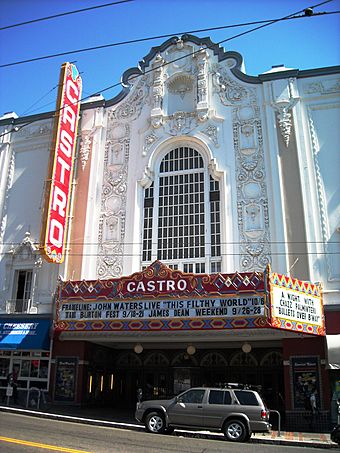Castro Theatre facts for kids

Front entrance of the Castro Theatre
|
|
| Lua error in Module:Location_map at line 420: attempt to index field 'wikibase' (a nil value). | |
| Location | 429 Castro Street San Francisco, California, U.S. |
|---|---|
| Public transit | |
| Owner | Nasser family |
| Type | Movie theater |
| Capacity | 1,400 |
| Construction | |
| Opened | June 22, 1922 |
| Architect | Timothy L. Pflueger |
| Designated: | 1977 |
| Reference #: | 100 |
The Castro Theatre is a famous old movie theater in the Castro District of San Francisco, California. It became a special San Francisco Historic Landmark in 1976. The theater is located at 429 Castro Street and was built in 1922. Its front looks like an old Spanish church, with a big arched window.
The theater's designer, Timothy L. Pflueger, also designed the Paramount Theater in Oakland. The Castro Theatre has over 1,400 seats, with about 800 downstairs and 600 in the balcony.
Contents
History of the Castro Theatre
The very first Castro Theatre opened in 1910 at 479 Castro Street. That building later became a store. The bigger, new Castro Theatre, which is still there today, opened a few doors down at 429 Castro Street.
The new Castro Theatre had its first special showing on June 22, 1922. The mayor of San Francisco, James "Sunny Jim" Rolph, was there. The movie shown was Across the Continent. The theater opened to everyone the next day.
The Nasser family built the theater and still owns it. They also owned other movie theaters in the San Francisco area. The inside of the Castro Theatre is very fancy and decorated. It has a huge "Mighty Wurlitzer" pipe organ that is played before movies and events. The large neon "Castro" sign outside is a symbol of both the theater and the Castro neighborhood.
Location and Getting There
The Castro Theatre is on Castro Street, close to where Market and 17th streets meet. It's right across from the Castro Street Station, which is part of the city's subway system called Muni Metro.
What Happens at the Castro Theatre Today?
Before the COVID pandemic in 2020, the Castro Theatre showed many different kinds of movies. It also hosted film festivals and special events. These often focused on LGBT and different cultures. Some of the festivals included the San Francisco International Film Festival and the San Francisco Silent Film Festival.
The theater also held special events honoring famous Hollywood stars. Many of these events were put on by a local organizer named Marc Huestis.
In 2008, the theater's neon sign and front were fixed up for the movie Milk. This movie was about Harvey Milk, a San Francisco city leader who was the first openly gay elected official in California. The movie, starring Sean Penn, had its first showing at the Castro Theatre in November 2008.
The theater can show modern digital movies in high quality. It can also show classic silent films at the correct speeds. It is one of the few theaters in the world that can show special 70mm films with a separate sound system.
New Management and Changes
In January 2022, a company called Another Planet Entertainment (APE) took over the lease for the Castro Theatre. They planned to reopen it in January 2023. APE wanted to host more live music, comedy, and other events, along with movies. They also planned to improve the sound, lighting, and heating systems.
These plans made some people in the local film community worried. They feared that the theater might stop showing as many movies. There were also concerns about the future of the famous pipe organ.
Saving the Historic Seating
APE's plans for the Castro Theatre have also caused some disagreement. Groups that want to protect historic places and LGBTQ culture are concerned. APE suggested changing the main floor of the theater. They wanted to remove the sloped floor and rows of seats to create flat areas for standing concerts.
Many people believe that the theater's classic movie-palace seating is a very important part of its history. They started a "Save the Seats" campaign. This campaign includes film fans and the LGBTQ community. They argue that the theater can still be successful without changing its original seating from 1922. Groups like the Castro Theatre Conservancy and the Castro LGBTQ Cultural District are leading this effort.
The Castro Theatre Organ
The organ that is now a symbol of the theater was added in the 1980s. It is a "Mighty Wurlitzer" pipe organ. In 2015, the owner of that organ moved it away.
A new, very large organ was then installed. It is considered the biggest "hybrid" organ ever built. It has 7 keyboards and many different sounds. It has about 1,200 real pipes, and it can also create sounds from a virtual orchestra. The bottom keyboard was made longer so it can play a full piano.
The design of the organ's control panel was made to be easy for the musician to use during a performance.
Images for kids
See also




